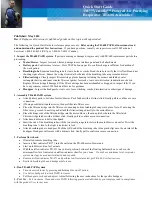
–
53
–
10-4. Outdoor Unit
10-4-1. Installation Place
• A place which provides enough space around the
outdoor unit as shown in the diagram.
• A place which can bear the weight of the outdoor
unit and does not allow an increase in noise level
and vibration.
• A place where the operation noise and
dis
charged air do not disturb
your
neighbors.
• A place which is not exposed to a strong wind.
• A place free of
a leakage of
combustible gases.
• A place which does not block a passage.
• When the outdoor unit is to be installed in an
elevated position, be sure to secure its feet.
•
An allowable length of the connecting pipe is up
to 20 m.
• There is no need to add refrigerant as long as the
length of the connection piping is 15 m or less.
• You will need to add 20 g of refrigerant per
meter of added connection piping for
installations requiring connection piping to be
between 16 m to 20 m.
• An allowable height level is up to 10 m.
• A place where the drain water does not cause any
problems.
FILE NO. SVM-12053
1.
Insall the outdoor unit in a location where there are
no obstructions near its air intake or air outlet.
2.
When the outdoor unit is installed in a place that
is always exposed to strong wind like on the coast
or on a high story of a building, secure the normal
fan operation using a duct or a wind shield.
3.
Especially in windy areas, insall the unit to
prevent the admission of wind.
4. Installation in the following places may result in
trouble.
Do not install the unit in such places.
•
A place full of machine oil.
•
A saline-place such as the coast.
•
A place full of sulfide gas.
•
A place where high-frequency waves are likely
to be generated
,
such
as from audio equipment,
welders, and medical equipment.
CAUTION
Strong
wind
Fig. 10-4-
1
90
°
Roughness Warp
Obliquity
1. Cut the pipe with a pipe cutter.
Fig. 10-4-2
2. Insert a flare nut into the pipe, and flare the pipe.
•
Projection margin in flaring : A (Unit : mm)
10-4-2. Refrigerant piping connection
<Flaring>
CAUTION
<Tightening connection>
Align the centers of the connecting pipes and tighten
the flare nut as far as possible with your fingers. Then
tighten the nut with a spanner and torque wrench as
shown in the figure.
Outer dia. of copper pipe
R410A
∅
6.35
1.5 to 2.0
∅
12.70
2.0 to 2.5
Outer dia.
A
of copper pipe
Rigid
Imperial
∅
6.35
0
to
0.5
1.0 to 1.5
∅
12.70
0
to
0.5
1.0 to 1.5
A
Die
Pipe
Fig. 10-4-3
Rigid (cluch type)
Imperial (wing nut type)
Half union
Flare nut
Externally
threaded side
Internally
threaded side
Use a wrench
to secure.
Use a torque wrench
to secure.
Fig. 10-4-4
















































